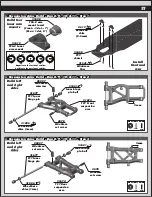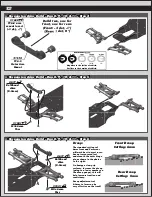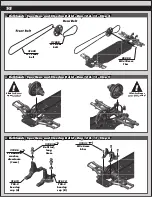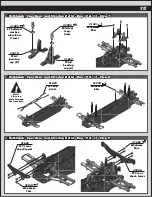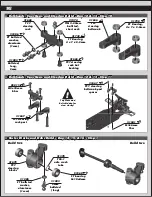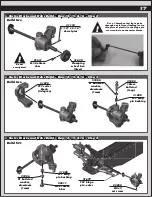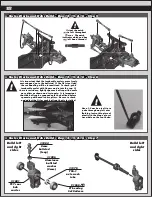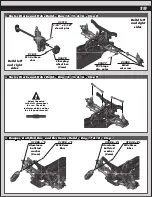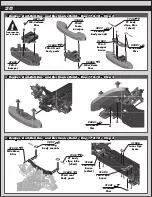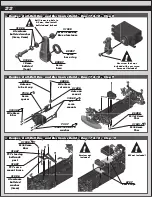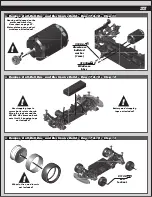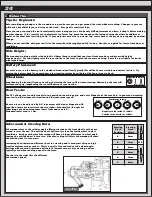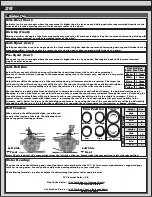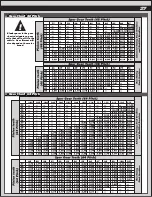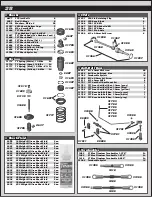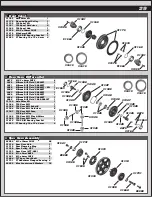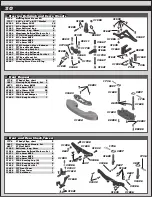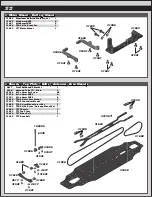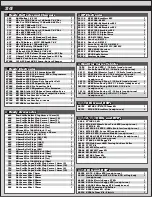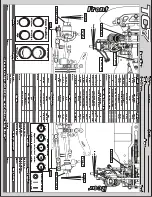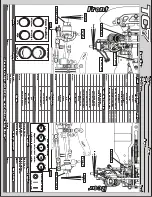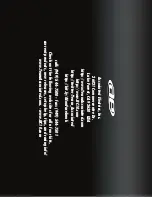
:: Tuning Tips
Camber Link Position:
The camber link is used to set static camber at ride height, but it is also an effective setting to adjust roll center height and camber
gain. The TC7 has three optimized length positions at the front, and six at the rear, for a wide range of camber gain adjustments.
All camber link mounting positions use vertical ballstuds that can be shimmed for precise roll center height adjustments.
Longer links will produce less camber gain, stiffening that particular end of the car in roll. These are particularly effective on large
tracks with big sweeping corners. Shorter links will give more camber gain, softening that end of the car in roll. This will make the
car more aggressive, and is a good setting for smaller indoor tracks with high grip levels.
The angle of the camber link will make fine adjustments to the roll center height. Typically the camber link will be no more than
parallel to the suspension arm with the inboard side of the link lower than the outboard side. As the inboard side of the camber link
is moved down, the roll center goes up, stiffening that end of the car. Camber link angle is a good adjustment to help fine tune the
balance of the car to the track by setting the front and rear at slightly different angles.
Arm Mount Position:
The TC7’s arm mount system allows for maximum adjustability for all track and racing conditions. Independent inner and outer arm
mounts with interchangeable inserts provide multiple pin configurations... flat, or with angle, to give a host of kickup/tow and pin
width options.
Use the TC7’s included arm mount inserts to adjust pin width and angle. The arm
mount inserts are indicated one, two, and three with the corresponding amount of dots
on their exposed face. Each insert will index the hinge pin by 1/2 degree (or 0.43mm).
Standard pin angle is achieved when using the same insert in both the inner and outer
mounts. Rear hinge pin angle is 3° when using the same insert in both inner and outer
mounts.
The chart to the right shows the pin angle change for the right rear pin when
using a 1 dot insert in the inner arm mount.
Pin width can also be adjusted by changing the inserts in the inner and
outer mounts by an equal amount. The standard pin width for the TC7 uses
-3 dot inserts for the front and 1 dot inserts for the rear.
This is best suited for rubber tire racing.
The TC7’s independent inner and outer arm mount system also allows for
roll center height adjustements as well as options for anti-dive/kick-up and
anti-squat/pro-squat hinge pin angles. Precise adjustments can be made by
changing the shim thickness between the arm mounts and chassis.
The standard roll center height uses 0.5mm shims on all mounts.
This produces a relatively low roll center with more chassis roll on the
corners... typically good for lower grip conditions such as rubber tires on
asphalt. If the grip level is high, try raising the roll center by using thicker
shims between the mounts and chassis.
Anti-dive/kick-up and anti-squat/pro-squat angles can be adjusted by
varying the amount of shims under the inner and outer mounts. A 0.5mm
difference will produce an angle of about 1/2 degree. The following
sections briefly describe front and rear pin angles and their effect on the track.
25
Droop:
The standard settings of 6mm front and 5mm
rear will work best in most cases. Droop is
measured just underneath the outer hinge pin
as shown in the photos to the right.
On bumpy or low grip surfaces, increase the
droop (going to a lower number on the droop
gauge), this will help increase traction and
consistency.
Droop adjustments of 0.5mm to 1mm can be
very effective on the track!
Arm Mount Inserts
Negative to the inside of vehicle.
Positive to the outside of vehicle.
1
DOT
0
°
-2
DOT
-1/2
°
+2
DOT
+1/2
°
-1
°
-3
DOT
+3
DOT
+1
°
1
2
3 4
A B C
Rear Droop
Setting: 5mm
1
0
2 3 4 5
6 7 8
1
0
2 3 4 5
6 7 8
Front Droop
Setting: 6mm
Summary of Contents for TC7
Page 1: ......

